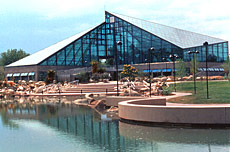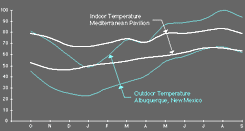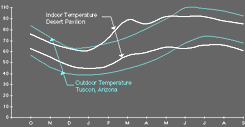
Most contemporary buildings, like machines, can be viewed as isolated systems. This means they need energy to operate but do not necessarily need to interact with their environment to continue functioning. Like all isolated systems, these buildings will operate according to the Second Law of Thermodynamics. They import energy in the form of electricity, propane and/or natural gas, convert that energy to run heating, cooling, ventilation equipment and lighting fixtures, and then dissipate that energy as waste heat. These buildings require an uninterrupted supply of imported energy to operate. Otherwise, after all the energy is consumed, they become uninhabitable; too hot, too cold, no light, etc. They insulate themselves against the environment for as long as possible in an effort to preserve their internal conditions. Living organisms on the other hand, function quite differently. They are open systems, which means they must maintain a continuous flow and exchange of energy and matter with their environment in order to stay alive. Through the process known as metabolism, they take in substances to obtain both energy and nutrients needed for vital functions, such as pumping of the heart, muscular contraction or for organic molecule production. At the same time open systems also have a high degree of stability and resiliency. This stability and resiliency is dynamic and consists of maintaining the same overall structure in spite of changes in the environment. Machines for example, will fail if their parts do not work in a very specific manner; if a part breaks down or if its energy source is inadequate or interrupted, whereas a living organism will maintain itself and keep itself operating in a changing environment by repairing and renewing itself. This ability to adapt and self-maintain in a constantly changing environment is an essential quality of open systems. Fluctuations play a key role in the resiliency of these systems. The elements that make up a system fluctuate within certain limits so that the system maintains its flexibility in a balanced state of continuous movement. As one element fluctuates in one way, other elements will compensate, within their range of movement, to keep the system stable. It is in this way that open systems, as a whole, adapt to environmental changes. A living organism also creates its own boundary which defines it as a distinct open system. This boundary, or membrane, is a filter of the environmental elements needed to sustain the organism. The boundary also encloses a specific set of internal relationships, an order that distinguishes one organism's existence from any other. Order is then a particular configuration or pattern of relationships that defines a specific open system and gives that system its form. To understand and visualize form we can map the patterns of relationships that make up the system. Form is then both the envelope and contents that make up a system. It is the visual nature of that system.
The form of the conservatory is a model, or reflection of our understanding of the underlying pattern of relationships that define the living organisms housed in each pavilion. Each pavilion is conceived as an open system, characterized by a continuous exchange of energy and matter with the environment in order to maintain internal conditions suitable to its particular resident plant life. The building skin, its glazing, vents, masonry and insulation filter the environmental elements needed to sustain the system and to create specific internal conditions for healthy plant growth. Sunlight enters each pavilion from all directions through the glazed portion of the building's skin, each surface having specific solar transmission and thermal properties. The glazing was selected for its transmission of sunlight or solar radiation in the blue (450nm), red (660nm) and far-red (750nm) wavelengths; the spectrum most needed by plants for photosynthesis. Outdoor air is admitted, regulated, directed and discharged through openings at the base and at the apex of each structure. A computer simulation model was generated to determine the specific properties of building elements; the envelope to filter and regulate the exchange of energy and matter with the environment; the concrete walls and floor, metal structure, soil, water and plants to absorb, convert, store and release energy for system stability; and the location and size of openings for natural and induced ventilation. Rather than creating a model to just predict the operation of the systems, we played with the model to see what would happen when we changed variables. We changed building materials, size and location of openings, glazing properties and rate of air and heat exchange with the environment at different times of the year, to name just a few. Variables were adjusted in order to learn more about the systems performance, its daily and seasonal fluctuations, and to match that performance against the climatic conditions required for the plant life in each pavilion. The computer model was used as a tool to increase our intuition about how each system worked and to make educated choices about system materials and operations. For example, in the Mediterranean Pavilion the southwest sloped roof glazing has a 45% light transmittance in the visible spectrum and only a 19% solar gain transmittance which is important in controlling system overheating during the hot Albuquerque summers. The vertical south facade glazing, on the other hand, has a 60% visible light and 30% solar gain transmittance which is important for improved winter performance of the system. Using the computer model, the design of each pavilion was fine tuned so that the relationships between system components produced dynamic internal environments that closely resembled that of Sonoran Desert and Mediterranean Basin climates. Small mechanical systems were then added, hot-water baseboard heating, fan induced natural ventilation, and a fogger system in the Mediterranean Pavilion, to eliminate the thermal peaks and valleys (overheating and underheating) that occurred during severe and atypical weather conditions. It should be noted that the mechanical systems for the pavilions were extremely small and inexpensive and comprised only 15% of a total construction budget of $1,580,000 as compared to 35% to 45% for a conventionally designed conservatory. The heating system, which is rarely used, is programmed to turn-on only when the outdoor temperature falls below 20 degrees F. The Conservatory has been open to the public and monitored for over a year. Upon close examination of its performance during this period, each pavillion exhibits a remarkably high degree of internal thermal order characteristic of living systems. Through the ceaseless exchange of energy and matter with the environment, the pavillions are able to renew and maintain themselves in a dynamic state that is very stable over time. Recorded data reveal that during the winter months both pavillions continually sustain temperatures that are 20 to 30 degrees above outdoor lows. Daily temperature fluctuations are consistent within a narrow range of 15 to 20 degrees in both summer and winter, and when the annual temperature profile of each pavillion is matched against that of a Sonoran Desert (Tucson, Arizona) and Mediterranean Basin (Los Angeles, California) climate, their profiles are strikingly similar. If, by design, we can create desirable indoor conditions in a conservatory with little or no imported energy, it should come as no surprise that it can easily be accomplished in other building types as well, such as housing, educational and recreational facilities, commercial buildings, libraries, etc. The order of the Rio Grande Conservatory is, however, not only the pattern of relationships that define it as an open system, but also the pattern of relationships that define its architectural form. Architectural form then, encloses a particular order that distinguishes one form from any other. This order can be purely rational and functional and based on scientific principles, or, it can speak to relationships that lie beyond the circumstantial, to relationships that address the underlying principles behind all living things. The language used to express these latter principles is the language of the architect, expressed in architectural form through number and geometry. Number and geometry are powerful symbols. While ordinary language facilitates attaining knowledge through reason, insight into the underlying qualities present in nature is explored through the arts, the language of symbols. Symbols themselves are revelations of this underlying visual beauty in our world, a permanent quality in a world of continual change. The geometrical symbol or figure that reappears throughout history as the embodiment of this quality is the squared circle. Leonardo DaVinci's Vitruvian figure inscribed in the square and circle is a symbol of the geometric and proportional relatiohships that exists in the natural world. The power of the squared circle as a symbol lies in its geometric and numeric qualities. The squared circle is the underlying geometry behind the design of the Rio Grande Conservatory. Throughout the Conservatory there is self-similarity, meaning the same geometric patterns derived from the diagram can be found at the various scales of the building. The proportional relationships carry through from plan to elevation, to the building components that make up the Conservatory's enclosure. While the Conservatory is a pattern of relationships in itself, it is also only one element in the Albuquerque Biological Park. The conservatory building is located at the narrowest point within the Park site, divides the site in two, and is the visual and symbolic center of the Park complex. To one side of the Conservatory is the entry pavillion, aquarium and structured theme gardens, and to the other side, a rustic "bosque" or riparian wooded area along the banks of the Rio Grande river. The center of the Conservatory, the point where the Desert and Mediterranean pavillions meet, is both physically and visually the highest point within the Park. Both parts of the site are unified through this point by an opening cut through the center of the building. By incorporating sustainable design strategies patterned after nature, the Rio Grande Conservatory has been able to maintain the internal conditions required for desert and Mediterranean plant growth with little or no outside energy input. |



